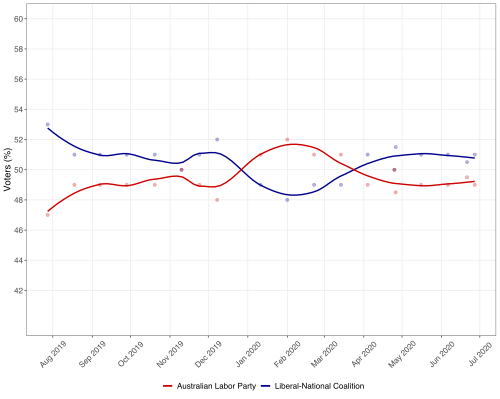Next Australian federal election
The next Australian federal election will be held in or before 2022 to elect members of the 47th Parliament of Australia.
| |||||||||||||||||||||||||||||||||||||||||||||||||||||||||||||||||
All 150 seats in the House of Representatives 76 seats are needed for a majority 40 (of the 76) seats in the Senate | |||||||||||||||||||||||||||||||||||||||||||||||||||||||||||||||||
|---|---|---|---|---|---|---|---|---|---|---|---|---|---|---|---|---|---|---|---|---|---|---|---|---|---|---|---|---|---|---|---|---|---|---|---|---|---|---|---|---|---|---|---|---|---|---|---|---|---|---|---|---|---|---|---|---|---|---|---|---|---|---|---|---|---|
| Opinion polls | |||||||||||||||||||||||||||||||||||||||||||||||||||||||||||||||||
| |||||||||||||||||||||||||||||||||||||||||||||||||||||||||||||||||
| |||||||||||||||||||||||||||||||||||||||||||||||||||||||||||||||||
All 151 seats in the House of Representatives (lower house) and 40 of the 76 seats in the Senate (upper house) will be up for election.
The incumbent Liberal/National Coalition Government, currently led by Prime Minister Scott Morrison, will be seeking a fourth three-year term. The Labor Opposition, currently led by Opposition Leader Anthony Albanese, and several minor parties will also contest the election.
Previous election
Result
Redistribution
The Australian Electoral Commission is required, one year after the first sitting day for a new House of Representatives, to determine the number of members to which each State and Territory is entitled. If the number in any state changes, a redistribution will be required in those states. A redistribution will be postponed if it would begin within one year of the expiration of the House of Representatives.
Demographic statistics for December 2019 released by the Australian Bureau of Statistics on 18 June 2020 will be used to calculate the determination. The population counts confirmed that the number of seats in the House of Representatives will return to 150, with Victoria gaining a seat (39) and Western Australia (15) and the Northern Territory (1) losing a seat each.[1]
Voter registration
Enrolment of eligible voters is compulsory. Voters must notify the AEC within 8 weeks of a change of address or after turning 18. The electoral rolls are closed for new enrolments or update of details about a week after the issue of writs for election.[2][3]
Election date
The date and type of federal election is determined by the Prime Minister – after a consideration of constitutional requirements, legal requirements, as well as political considerations – who advises the Governor-General to set the process in motion by dissolving the lower or both houses and issuing writs for election. The Constitution of Australia does not require simultaneous elections for the Senate and the House of Representatives, but it has long been preferred that elections for the two houses take place simultaneously. The most recent House-only election took place in 1972, and the most recent Senate-only election took place in 1970. The election day must be a Saturday.[4]
An election for the House of Representatives can be called at any time before the expiration of the three-year term of the House of Representatives[5] or up to ten days thereafter.[6] The term of the House of Representatives starts on the first sitting day of the House following its election, which in the case of the 46th Parliament was 2 July 2019. The Commonwealth Electoral Act 1918 (CEA) sets certain requirements. Up to 27 days must be allowed for nominations,[7] and the actual election can be set for a maximum of 31 days after close of nominations,[8] resulting in the latest election date for the House of Representatives being after the latest possible date for the next senate election.
The election of senators must take place within one year before the terms expire for half-Senate elections,[9] so that the writs for a half-Senate election cannot be issued earlier than 1 July 2021. Since campaigns are for a minimum of 33 days, the earliest possible date for a simultaneous House/half-Senate election is Saturday, 7 August 2021.[10] The latest that a half-Senate election could be held must allow time for the votes to be counted and the writs to be returned before the newly elected senators take office on 1 July 2022. This took 41 days in 2019, and were returned on the last possible date available given the impending commencement of the new senators. Using this approximate time frame, the last possible date for a half-Senate election to take place is Saturday 21 May 2022.
A double dissolution (a deadlock-breaking provision to dissolve both houses of parliament) cannot take place within six months before the date of the expiry of the House of Representatives.[11] That means that any double dissolution of the 46th Parliament will have to be granted by 1 January 2022. Allowing for the same stages indicated above, the last possible date for a double dissolution election would be in March 2022.[10] This can only occur if a bill that passes the House of Representatives is rejected by the Senate twice, at least three months apart.
Constitutional and legal provisions
The constitutional and legal provisions which impact on the choice of election dates include:[12]
- Section 12 of the Constitution says: "The Governor of any State may cause writs to be issued for the election of Senators for that State".
- Section 13 of the Constitution provides that the election of senators shall be held in the period of twelve months before the places become vacant.
- Section 28 of the Constitution says: "Every House of Representatives shall continue for three years from the first sitting of the House, and no longer, but may be sooner dissolved by the Governor-General."[13] Since the 46th Parliament of Australia opened on 2 July 2019, it will expire on 1 July 2022.
- Section 32 of the Constitution says: "The writs shall be issued within ten days from the expiry of a House of Representatives or from the proclamation of a dissolution thereof." Ten days after 1 July 2022 is 11 July 2022.
- Section 156 (1) of the CEA says: "The date fixed for the nomination of the candidates shall not be less than 10 days nor more than 27 days after the date of the writ".[7] Twenty-seven days after 11 July 2022 is 7 August 2022.
- Section 157 of the CEA says: "The date fixed for the polling shall not be less than 23 days nor more than 31 days after the date of nomination".[8] Thirty-one days after 7 August 2022 is 7 September 2022, a Wednesday.
- Section 158 of the CEA says: "The day fixed for the polling shall be a Saturday".[14] The Saturday before 7 September 2022 is 3 September 2022. This is therefore the latest possible date for the lower house election.
Candidates
Candidates for either house must be formally nominated with the Electoral Commission. The nomination for a party-endorsed candidate must be signed by the Registered Officer of a party registered under the Electoral Act. Fifty signatures of eligible voters are required for an independent candidate. A candidate can nominate for only one electorate, and must pass a number of qualifications.
A deposit of $2,000 will be required for a candidate for the House of Representatives or the Senate, which is refunded if the candidate is elected or gains at least 4% of the first preference vote.[15][16] Between 10 and 27 days must be allowed after the issue of writs before the close of nominations.[7]
Retiring members
Members of Parliament and Senators who chose not to renominate for the upcoming election are as follows:
Liberal
- Senator Scott Ryan (Vic) – announced retirement on 9 March 2020.[17]
Opinion polling
Notes
- 1.^ Robbie Katter sits as an MP in the Parliament of Queensland for Traeger.
References
- Green, Antony. "ABS Population Statistics Confirm Changes in House Representation". Antony Green's Election Blog. Retrieved 18 June 2020.
- Commonwealth Electoral Act 1918 (Cth) s. 155
- "DOCUMENTS RELATING TO THE CALLING OF THE DOUBLE DISSOLUTION ELECTION FOR 2 JULY 2016" (PDF). Governor-General of the Commonwealth of Australia. 8 May 2016. Archived from the original (PDF) on 8 May 2016.
- "Commonwealth Electoral Act, s. 158". Austlii.edu.au. Retrieved 19 March 2018.
- Constitution of Australia, s. 28.
- Constitution of Australia, s. 32.
- "Commonwealth Electoral Act, s. 156". Austlii.edu.au. Retrieved 19 March 2018.
- "Commonwealth Electoral Act, s. 157". Austlii.edu.au. Retrieved 19 March 2018.
- Constitution of Australia, s. 13
- Elections Timetable from Parliamentary Library
- Section 57 of the Constitution
- Lundie, Rob. "Australian elections timetable". Parliament of Australia. Archived from the original on 8 January 2011.
- "Commonwealth Of Australia Constitution Act – Section 28". Austlii.edu.au. Archived from the original on 24 April 2016. Retrieved 2 July 2018.
- "Commonwealth Electoral Act, s. 158". Austlii.edu.au. Archived from the original on 4 March 2016. Retrieved 2 July 2019.
- The Electoral Legislation Amendment (Modernisation and Other Measures) Act 2019, which came into effect on 1 March 2019.
- Candidates Handbook, p.6.
- Foley, Mike (8 March 2020). "Senate President Scott Ryan calls time on parliamentary career". The Sydney Morning Herald. Retrieved 9 March 2020.


.jpg)



